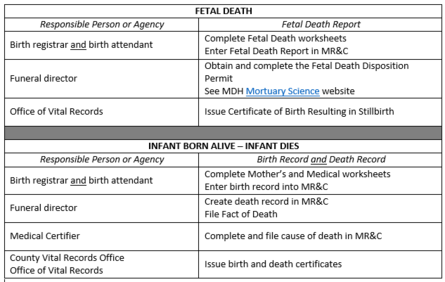Timely death data of great value to local public health
By Rick Carlson
Epidemiologist, Minneapolis Health Department
Newly available death data from the Office of Vital Records (OVR) is already demonstrating great value to local public health. Since mid-June, OVR has shared coded death records in real time. The process involves posting a weekly file containing International Classification of Diseases, 10th Revision (ICD-10) coded, year-to-date deaths on a secure site so that public health agencies can access the data. The change is just one of many that propagated from the Minnesota Death Data Delivery Project, an intensive process improvement project that kicked off with a week-long event that took place in May.
For local public health, the so-called “real-time” death data provides a nice complement to annual, “finalized” death data. Finalized data is validated for quality assurance and includes all deaths within a given year. However, this all-or-nothing process means some records may be delayed for as long as 22 months from the actual death event. Real-time death data, on the other hand, is not subject to the same validation or holding times. Instead, the records are available soon after the National Center for Health Statistics (NCHS) applies ICD-10 codes which assign numbers to the cause of death that physicians and medical examiners provide on a decedent’s death record.
How will the data be used? What are the anticipated benefits? First, the new data sharing process will help revive local surveillance. Local public health wants to feel the “pulse” of the mortality landscape at all times. The substantial reduction in wait time for data enables a more timely response to emerging issues (e.g., drug overdose deaths). Second, the new process will leverage local analytic capacity. The leveraging effect may help “move the dial” on persistent public health issues such as traffic fatalities and the “toward zero deaths” initiative; infant mortality and sudden, unexpected infant death; and other efforts.
For metro-area agencies, the tangible applications of the new data are unfolding. For example, the City of Minneapolis is incorporating 2014 death data into the Big Cities Health Inventory. The Metro Public Health Analysts Network, which consists of nine metro-area agencies, is exploring opportunities to conduct surveillance around 18 mortality indicators and share standard ICD-10 methodology between partners.
As part of the process improvement project, OVR is sharing real-time death data with selected local public health agencies and programs within the Minnesota Department of Health. OVR will consider future expansion to include other users after the project evaluation later this year and as resources allow.
 On June 17, 2015, the vendor that supplies Minnesota’s vital records security paper, Northern Bank Note/Sekuworks, suspended production. Initially the Office of Vital Records (OVR) and other jurisdictions were told that the operational shutdown was temporary. Printing has not resumed and work is underway at the State to secure a contract with a new vendor.
OVR expects to have a new contract in place by August 10. Because the new vendor will need time to design, proof, and print certificates, shipments of new paper will likely begin the first week of September. OVR is confident that statewide, we have enough security paper to meet the anticipated demand for birth and death certificates until the new shipments arrive
“Our priority is to assure that customer needs are met without issuance interruption and with minimal impact to service delivery,” said Molly Crawford, State Registrar. “Because the shutdown occurred without notice, advance planning was impossible.” Crawford said OVR is closely monitoring the paper supply at all 110 issuance offices through data in MR&C. Fortunately most sites had adequate inventory. OVR identified offices that were running lean and personally contacted sites that had less than a two-month supply of paper.
To address the immediate needs and prevent shortages, OVR shipped paper from its own supply overnight to 10 offices on July 23. With those emergency shipments and with larger counties leveraging their supplies among multiple offices, issuance offices should be equipped to meet customer needs and fulfill requests for certificates routinely and without delay.
Because certificate paper has many security features and because each sheet of paper has a unique document control number and unique number associated with the issuance site, changing suppliers and moving paper from one site to another can be complicated. OVR
will continue to work with specific sites to address any shortage issues that
may arise.
|
 On June 26, 2015, the United States legalized same-sex marriages in all 55 states and territories. This ruling made state-level bans on same-sex marriage unconstitutional. Minnesota legalized same-sex marriages in 2013. So although this is not new to our work, the Supreme Court decision and recent media attention are cause to take a look at how marriage relates to vital records.
Minnesota’s 87 counties play an important role in marriage activities. County offices issue marriage licenses before the event and certificates afterward. They have worked collectively and collaboratively to use gender neutral language such as using first and second applicant rather than terms such as bride and groom. The counties have also worked together through the Minnesota Association of County Officers to create and maintain the Minnesota Official Marriage System (MOMS). MOMS is a web-based application that contains a database of Minnesota marriage certificates (see https://www.moms.mn.gov/) that is available to the public.
Marriage impacts other vital records such as birth and death records. Long before same-sex marriage was legalized, Minnesota regularly placed same-sex parents on their children’s birth records through court-ordered adoptions. The 2013 decision in Minnesota allowed same-sex married couples to be recognized on vital records without a court order which has made our work less complicated.
Here is a breakdown for people who enter, correct and issue vital records:
Birth Records
The marital status of the mother is a key piece of information. Birth registrars should collect the mother’s marital status, her spouse’s information, and enter the spouse as the second parent regardless of the spouse’s gender. The mother’s disclosure is all that is needed - no proof of marriage is required. If the mother is unmarried, the birth registrar will enter only the mother’s name on her child’s birth record unless she and the biological father file a Voluntary Recognition of Parentage (ROP) form to establish paternity. This form cannot be used to add a female as the second parent.
In situations where the mother is married, but her spouse is not the biological father, another form called the Spouse’s Non-parentage Statement (SNPS) might be used. That form signed by the spouse along with the ROP allows the child’s birth record to list the biological father as the second parent rather than the mother’s spouse.
Same sex couples, married or not, may also present court orders for surrogacy, adoption and adjudication directing how a birth be registered or how a record be replaced by the Office of Vital Records.
Although the worksheets used to collect data reference mother and father in addition to the label parent, the birth certificates we issue label a subject’s parents as “parent.” Other non-certified documents vary in how data fields are labeled. As forms and other documents are revised, OVR will update all data fields with gender neutral language.
Death Records
For death records, the family of the decedent or an informant provides the legal information for the death certificate. This includes the decedent’s marital status and the name of the surviving or deceased spouse. Similar to birth records, no proof of marriage is required. Death certificates refer to a decedent’s parents with the label “Parent” and the marriage partner, if any, is labeled simply as “spouse.”
Marriage Certificates
The National Center for Health Statistics requires jurisdictions to report only the number of certificates they issue. Since 2005, OVR has collected data on only the number of certificates issued by county, although Minnesota law requires counties to collect other data in the marriage licensing process.
|
Understanding your role as birth registrar,
funeral director, county vital records officer
The Centers for Disease Control and Prevention (CDC) defines
fetal death as “the spontaneous intrauterine death of a fetus at any time during
pregnancy.”
It is important to distinguish between infant deaths and fetal
deaths and understand how they differ. Medical and nursing communities may use
the terms interchangeably, and sometimes the term stillbirth is used by others
and that contributes to confusion. Specificity and clarity are important to
accurate and timely vital records. The vital statistics community documents and
handles the intrauterine death of a fetus differently from the death of a live-born infant.
Fetal death reports are filed for intrauterine deaths. A birth
record and a death record are filed for a baby who is born alive and then dies
– even if the length of the baby’s life is very brief.
In Minnesota, the law requires a report of fetal death
to be filed in MR&C within five days of the death of a fetus for whom 20 or
more weeks of gestation have elapsed. If the fetal death occurs before 20 weeks
of gestation, the parent(s) can decide whether or not to have a fetal death
report filed. A fetal death report must be filed regardless of the gestational
age of the fetus if the parent(s) want a Certificate of Birth Resulting in
Stillbirth.
No birth record or death record is filed for an intrauterine
fetal death, just the fetal death report. Hospital birth registrars or other
hospital staff generally file fetal death reports. Sometimes parents file a
report directly with OVR when the event occurs outside of a facility. Even
though it is a death, funeral establishment staff do not have access to the
Fetal Death Report module in MR&C. However,
funeral homes and funeral directors prepare the Fetal Death Disposition Permit
to bury or cremate the fetal remains.
Any time a birth occurs and the infant lives for any amount of
time before dying, both a birth record and a death record must be filed.
Disposition for a newborn’s body follows the same requirements as for an adult
death. In these situations, the hospital files the birth record. The funeral
home creates the death record and the medical certifier completes the cause of
death.

|